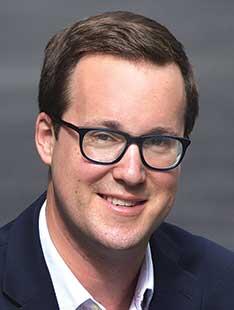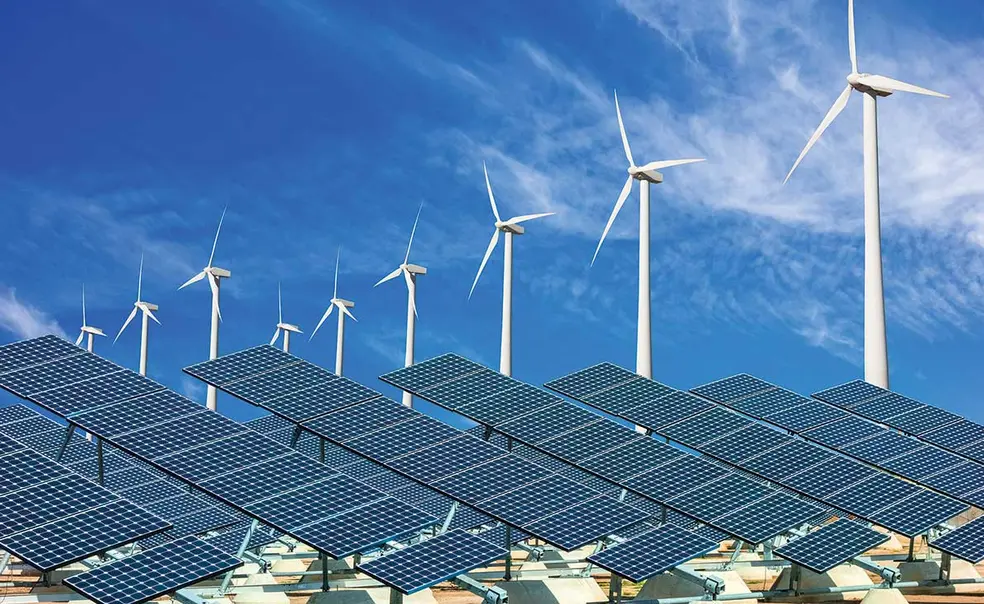Environmental Studies: The Paths to Net-Zero
A bold new study provides five affordable pathways for a clean-energy future

In a net-zero economy, the amount of greenhouse gases emitted into the atmosphere is balanced exactly by the amount removed. So what would it take for the United States to reduce its greenhouse-gas emissions to net-zero by 2050? A new report from Princeton — specifically from the Andlinger Center for Energy and the Environment and the High Meadows Environmental Institute — lays out five potential strategies for meeting this ambitious goal.
The report, “Net-Zero America,” concludes that transitioning to a net-zero carbon-emitting economy within three decades is not only possible, but can be done using technology that already exists, with a relatively low price tag: 4–6 percent of gross domestic product annually. That’s what the United States has historically spent on energy.
Yet the report also makes clear that decarbonizing our energy supply in such a short time is a daunting task. The process must begin immediately, starting with building a clean-energy infrastructure at an unprecedented scale and speed. A net-zero transition would also require rapid shifts in consumer behavior and land use: By 2050, Americans must embrace electric vehicles and adapt to a landscape transformed by wind and solar farms.
The research team behind the report was co-headed by the Andlinger Center’s Eric Larson, a senior research engineer; Chris Greig, senior research scientist; and Jesse Jenkins, assistant professor of mechanical and aerospace engineering. Seven additional Princeton researchers and eight external collaborators also contributed to the report, released in December as a 345-page summary of two years of research.
The report’s findings underscore the need for a unified, collaborative approach. As Jenkins explained to The Washington Post, “The costs are affordable, the tool kit is there, but the scale of transformation across the country is significant. This is a major national undertaking that will only happen if we have the right national commitment.”
FIVE PATHS, ONE GOAL
Scientists broadly agree that preventing carbon dioxide from accumulating further in the atmosphere is key to mitigating the worst effects of climate change. The Biden-Harris administration has pledged to work toward net-zero emissions and a switch to 100 percent clean energy by 2050.
The Princeton team mapped out five pathways that would bring the United States to net-zero within 30 years. The report is the first to examine the potential methods and consequences of decarbonization at a granular level, mapping the transition decade by decade, state by state, and even county by county.
Each of the five pathways assumes a significant overall increase in electrification, with a focus on energy derived from renewable sources, primarily wind, solar, and biomass. In four out of five pathways some use of fossil fuels would persist and would be offset by carbon capture to ensure a net-zero outcome. One pathway envisions a high reliance on biomass in the form of nonedible crops that can be used for both hydrogen fuel and carbon capture and storage. Carbon emissions vanish completely only under the fifth and most ambitious pathway, which relies on 100 percent renewable energy. It is the only pathway that posits no use of fossil fuels or nuclear power by 2050 and no underground carbon storage.
The report identifies economic benefits that would result from a net-zero economy. It says all five pathways would create between 500,000 and 1 million new jobs in the clean-energy sector by 2030. Job losses in fossil-fuel industries would be more than offset by new jobs created in almost every state. In states where job losses would not be offset, policymakers could create safeguards for affected workers.
The report also predicts major health advantages. All five pathways are said to prevent between 200,000 and 300,000 premature deaths due to air pollution by 2050. In each pathway, the use of coal would cease by 2030, avoiding 100,000 premature deaths from coal-related emissions by 2050.
The researchers avoid recommending one pathway over another. According to Greig, they don’t expect that any of the hypothetical pathways would be implemented exactly as written. Instead, they anticipate that policymakers would pursue a blend of approaches.
“We have to keep as many options alive and real as we can,” Greig said, which means keeping technologies like advanced nuclear energy, bioenergy, and carbon capture and storage in play during the near future. “If we start to take options off the table, then we risk running into unforeseen obstacles. We want to have the flexibility to pivot.”
OBSTACLES AND OPPORTUNITIES
The researchers are candid about the significant challenges their initiative will face. Outside experts who’ve responded to their work have emphasized that reaching net-zero may take longer than the ideal scenarios the report projects, due to inevitable hurdles like bureaucratic red tape, entrenched consumer habits, and political gridlock.
The report recommends wind- and solar-generated electricity increase between twofold and threefold by 2030. That target requires vast quantities of land. Under all three high-electrification pathways, the report envisions wind farms blanketing about 200,000 square miles, mostly in the Midwest — an area about the size of Colorado and Wyoming combined. Offshore wind farms would also take up significant space along the mid-Atlantic and New England coasts. This type of intensive land use is likely to encounter local opposition.
The energy also must be delivered. Under one of the high electrification pathways, the U.S must increase its electricity-transmission capacity 60 percent by 2030 and triple it by 2050. As Jenkins described in a press release, that means building the equivalent of the nation’s entire existing power grid over the next 15 years and then building the same amount again over the following 15.
The report assumes that between 61 percent and 96 percent of new cars in the United States would be electric by 2050. Today, fewer than 2 percent of new cars are electric.
For Joshua Drossman ’22, an ORFE major who contributed to the report, confronting the scale of structural change needed to reach net-zero was eye-opening. “In terms of building out electricity capacity, I hadn’t even considered the fact that you also need to build out transmission lines and distribution sites,” which can cost as much as the electricity-generation sources themselves, he noted. “There are all these hidden numbers that come into play.”
Greig, who spent years in the agriculture, mining, and energy industries before entering academia, is particularly aware of the need to build consensus around net-zero goals as quickly as possible. “Having the community accept the visual impact of wind farms and the massive amounts of infrastructure building is going to be critical, and it has to happen fast,” he says. “In my career, the one thing I’ve found is that if you want to bring the community along, don’t try to rush them”— yet in this case, he says, rushing is the only option.
The researchers are eager for their findings to have a tangible impact. In addition to briefings with policymakers and investors, they are preparing a website where their state-by-state data will be available for anyone to download.
In spite of the challenges ahead, Larson says that compared to other nations, the United States is “probably in a much better position to get this done because of our land and our resource base.” He adds that when it comes to the movement toward net-zero, “we have the potential to be a leader.”












4 Responses
Jim Mosley ’77
4 Years AgoThe Need for Getting to Net-Zero
In 1977 I was elected into the Sigma Xi honor society for excellence in scientific research in recognition of my senior thesis, “Solar Community: Bridge To the 21st Century.” My thesis outlined various pathways to reduce our dependence on oil.
There was no need to get all the way to net-zero back then. But after four decades of an extensive program to spread false information about the climate impacts of continued use of fossil-fuels, funded by that industry, and ExxonMobil in particular, here we are.
I applaud Princeton for creating the Andlinger Center and send my best wishes to all working on critical research there. Because now we do have to get to net-zero — and fast.
Unfortunately, you have a major hurdle to overcome to get your research taken seriously. You are getting funding from one of the companies most responsible for the above disinformation campaign. May I suggest that announcing that four out of the five pathways you are recommending still include using fossil-fuels for a significant percentage of our energy is not the best way to overcome this obstacle.
Instead, you reply with a nonsense answer about the above somehow leading to the extinction of the industry and a very Fox Newsy whine about divisiveness (Inbox, July/August issue). Methinks thou doth protest too much. I suggest that you provide a more reasonable response to very reasonable reactions to your unfortunate funding situation. And, while you are at it, how about just one more pathway without any fossil-fuels.
Steve Pacala , Chris Greig , Jesse Jenkins , Eric Larson
4 Years AgoTransitioning to a Net-Zero Emitting Energy System
The Princeton Net-Zero America Project (NZAP) shows that the U.S. could transition to a net-zero-emitting energy system over the next 30 years at a cost comparable to what the nation has spent on its fossil-dominated energy system over the last 30 years (On the Campus, February issue). This is true both for net-zero options that would be 100 percent renewable and for those that would retain some use of decarbonized fossil or nuclear sources. If NZAP’s fossil-fuel funders somehow guided these results, as Lynne Archibald ’87 suggested in a recent letter (Inbox, May issue), then the companies evidently wish to promote the extinction of their industry.
One of NZAP’s key findings is that actions needed in the 2020s are the same whether we are in pursuit of a 100 percent renewable energy system, or one that retains some nuclear or decarbonized fossil assets. The letter writer’s all-or-nothing argument is unnecessarily divisive and works against efforts to focus effectively on what we need to do now.
Lynne Archibald ’87
4 Years AgoFossil Fuels Funding Research at Princeton
The new study published by Princeton in December 2020 outlining five paths to a net-zero future (On the Campus, February issue) is laudable, but it is important that PAW readers know that the study was funded by fossil-fuel companies. According to the University’s announcement, funding for the research was provided by BP through the Carbon Mitigation Initiative at Princeton’s High Meadows Environmental Institute and ExxonMobil through a Princeton E-ffiliates Partnership at the Andlinger Center for Energy and the Environment.
That context is important when reading that “in four out of five pathways, some use of fossil fuels would persist and would be offset by carbon capture.” We can only imagine what might have happened had the research been funded by a neutral organization or even by a renewable energy company — perhaps it might still have been four to one, but the other way around?
Wilson Prichett ’70
4 Years AgoEngineering for Energy Conservation
This is something we (those of us in the field for nearly 50 years, now) have been aware of, basically, our whole working lives!
This particular article is full of ivory tower generalities that indicate the authors are not really familiar with the obstacles and details (in which lie the devils) to reach net zero.
Perhaps someone should consult a person who has personally engineered and continues to engineer renewable energy projects and energy conservation (the real road to net zero) for his whole life!
My projects (constructed under my engineering seal) have saved over a billion kilowatt hours and my master’s thesis subject (Environmental Effects of Large Scale Solar Power) is becoming a hot topic right now 50 years later.